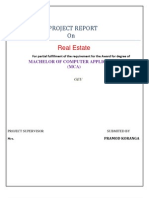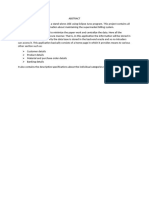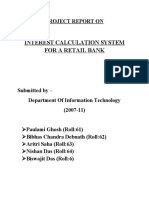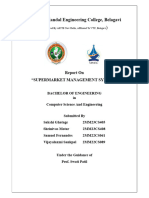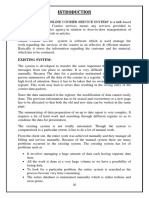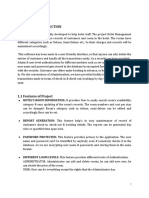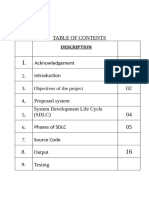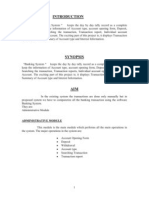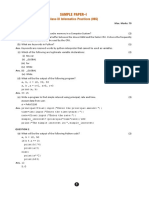3.2 Software Design Specification: Project Monitoring System
3.2 Software Design Specification: Project Monitoring System
Uploaded by
api-233583621Copyright:
Available Formats
3.2 Software Design Specification: Project Monitoring System
3.2 Software Design Specification: Project Monitoring System
Uploaded by
api-233583621Original Title
Copyright
Available Formats
Share this document
Did you find this document useful?
Is this content inappropriate?
Copyright:
Available Formats
3.2 Software Design Specification: Project Monitoring System
3.2 Software Design Specification: Project Monitoring System
Uploaded by
api-233583621Copyright:
Available Formats
Project Monitoring System
3.2 Software Design Specification
Software Design Specification
Page 1
Project Monitoring System
3.2.1 Introduction 3.2.1.1 Goals and Objectives It is important not only to meet the requirements of the system but also to surpass it in order to meet the expectations of the users. The proposed Project Monitoring System aims to help the LGU to have a system that will handle their records easily and safely. The proponents considered some related factor about the project monitoring to come up with a good plan and wanted to develop a software application developed using JAVA Eclipse IDE for the development surroundings and uses MySQL Server for the database server. It is computerized for faster project monitoring of the Municipality to be used by them. The Project Monitoring System is designed to establish a well-built recording, planning, determining direct project cost and scheduling of the different projects of Municipality. One of the most general jobs of project monitoring is scheduling and planning. Scheduling is used to sequence project activities and assign dates to them. The detail and sophistication of a schedule produced by a Project Monitoring System can lessen all the works. There are different objectives that the Project Monitoring system involves such as: To give a complete record for the user for the projects that is easily maintained, readily accessible and very comprehensive To prevent the duplication of project record To easily access and record projects To give convenient project monitoring process for the different Municipalities To give consistent record of complete, ongoing and realigned projects To give efficiency and gain access for the progression of a project To plan, organize, and schedule different approved projects in Municipality To influence the factors that cause changes to ensure that changes are beneficial, determine that a change has occurred, and manage actual changes as they occur. To enable a regular tracking of the progress made by the project, highlights areas for improvement in the design or implementation of the project and enables delivery of high quality results.
Software Design Specification Page 2
Project Monitoring System
The Project Monitoring System involves historical information on how projects have progressed, and in particular, how actual and planned performances are related. Users will be able to provide the needs of the Municipality. Innovation of the current system will be provided through the Project Monitoring System. It can produce a high quality and secured program. Security of the documents is highly recommended. The system enables users to robust the productivity work of city hall and lastly, it can give a complete record for the user that is easily maintained, readily accessible and very comprehensive.
3.2.1.2 Statement of Scope Monitoring of project progression is a critical component in the overall monitoring of a project. A projects ability to provide accurate, timely information to a variety of audiences may significantly affect the relationship the project has with its staff, monitoring, and beneficiaries of the project and outside funding agencies. In addition, the quality and accuracy of the project details reported to donors and other governmental entities can affect a projects funding, a projects credibility and the publics perception of a project. A project mon itoring strategy should be developed which will specify how project is created or collected, maintained, reported and stored. All projects should have a monitoring system; it may be informal and undocumented or formal and documented. Monitoring of project should be incorporated into the projects comprehensive monitoring system which includes all of a projects information needs. A projects monitoring system should address the use of both technological and human resources. Project Monitoring System has its scope. As a general the process of monitoring is included planning, implementation and evaluation of the projects that can cater all the projects of Municipality to make sure all development projects can be done consistently at all level and any problem occurs will straight away taken into action. An efficiency of monitoring system always needs to be upgraded from time to time with the introducing of some new method or system from the government due to the current technology changing.
Software Design Specification
Page 3
Project Monitoring System
Major Inputs Project name, description, start date, end date, duration, and cost Evaluation date, comment, risk Activity name, start date, end date, duration, cost Reminders to remember Risk involved Progression of project Change or modification for project Project Team incharge Personnel
Processing Functionalities Function Project Information Entry Evaluation information entry Reminders to remember Project Team incharge Risk involved Activities done Progression of project Changes in project Priority Essential Essential Desirable Essential Essential Essential Essential Essential
Output Actual vs. Planned Project Report, Actual Cost vs. Planned Cost Report, Semi-Annual Project Progress Reports, Executive Status Report
Software Design Specification
Page 4
Project Monitoring System
3.2.1.3 Software context A project needs to systematize its information into balanced easily understood categories to increase its access and use. By organizing information a project is able to: implement standards for the depiction of information; relate different pieces of information to one another in meaningful ways; protect information from destruction; and make information available for people to use. The organization, storage, and retrieval of projects information is a critical component of monitoring. The project needs to be able to find the specific information that best answer a query, and to collate information. With issues that arise, certain solution is needed in order to obtain a good and successful project monitoring aid. Information sources are significant to project needs, which at the beginning of the project can be quite large. All projects should have a monitoring system; it may be informal and undocumented or formal and documented. Monitoring of project should be integrated into the projects comprehensive monitoring system which includes all of a projects information needs. A projects monitoring system should deal with the use of both technological and human resources. A well-organized and competent monitoring system to the projects growth is the most vital aspect in order to ensure their performance will be going smooth and not be affected due to the present phenomenon of world economic.
3.2.1.4 Major Constraints The Project Monitoring System will use JAVA Eclipse IDE with the database server MySQL. The system should be excellent enough to perform all the actions fast.
3.2.2 Data Design As the application is being built in java and MySQL, the overall application design can be classified into three parts.
1. Front End Graphical User Interface 2. Back End Data 3. Internal Functional Procedures
Software Design Specification Page 5
Project Monitoring System
Graphical User Interface (GUI) Java is being used for the development of the front end GUI. The GUI components temporarily stores the keyboard input by the users till its being used by the functional procedures.
Back End Data For the back end, we are using the MySQL for storing all the information in the form of tables. These tables will be globally accessible to all the internal procedures.
Internal Functional Procedures The internal functional procedures are the logical entities that take out dissimilar task of adding, updating, deleting, viewing or printing the database.
3.2.2.1 Internal Software Data Structure There are no data structures available to the internal software architecture. The intermediate information while updating or adding to any table is stored in the java swing component. When the add or edit and update button is pressed the information in those text fields is directly sent to the database for add or update. For the report printing temporary local variables have been defined in the procedures with significant names to store different values and then print the report.
3.2.2.2 Global Data Structure The only kind of data available globally to the whole system is the database itself stored in MySQL.
3.2.2.3 Temporary Data Structure The Project Monitoring application doesnt use any intermediate temporary files of its own. As data being stored by the DBMS until the command commit is executed in the SQL query by the application.
Software Design Specification
Page 6
Project Monitoring System
3.2.2.4 Database Description
Below are mentioned all tables, their corresponding attributes and a small description of each.
Table Name: Project Attributes: Project Name, Description, Contract Agreement, Start Date, End Date,
Actual Start Date, Actual End date, Project Cost, Evaluator, Activity, Project Team Description: It holds the general information about certain projects. The primary key of this table is Project ID.
Table Name: Activity Attributes: Name, Start Date, End Date, Actual Start Date, Actual End Date, Duration, Risk, Cost, Actual Cost Description: It holds information about the activities done and ongoing. The primary key of this table is Activity ID.
Table Name: Progress Attributes: Progression, Project, Document, Photo Description: It holds the information about the progression of a project. The primary key of this table is Progress ID.
Table Name: Change Attributes: Change, Date, Event Description: Holds information about changes that occur for a project. The primary key of this table is Change ID.
Table Name: Reminder Attributes: Date, Message, Project Description: Reminds the user about a certain project. The primary key of this table is Reminder ID.
Software Design Specification Page 7
Project Monitoring System
Table Name: Risk Attributes: Name, Description Description: Holds information about the risk involved. The primary key of this table is Risk ID.
Table Name: Evaluation Attributes: Evaluator, Date, Project, Comment, Risk Description: Holds information about the evaluated projects thru the work done by the evaluator. The primary key of this table is Evaluation ID.
Table Name: Project Team Attributes: Name, Leader, Member Description: The project team holds information about the team who handles a project. The primary key of this table is Project Team ID.
Table Name: Personnel Attributes: Username, Password, First Name, Last name, Access category Description: It holds the information about the personnel who uses the system. The primary key of this table is Personnel ID.
3.2.3 Architecture and Component Level Design
3.2.3.1 Architectural Diagram
The architectural context diagram for the project monitoring system is shown below. As it is clear from the diagram, various actors are admin, project managers and mobile users which will use the system. The subordinate systems that will be used by the software are the database (MySQL) and Java. Also, NetBean is a tool to connect the java to the database. Maintenance system is super ordinate, which needs the software for testing and maintenance purposes.
Software Design Specification
Page 8
Project Monitoring System
Figure 1: Architectural Diagram
3.2.3.2 Description of Components
3.2.3.2.1 Component Project 3.2.3.2.1.1 Processing narrative of component Project The component project contains the class Project. It contains the attributes, which are the basic data of the project. It contains the functions, which sets all the related data into and out of the database. The class project contains the data members and functions, which are unique to the project. The responsibilities of this component is to declaring variables of the basic data of the project and implementing functions which set data in the database and retrieve from the database.
Software Design Specification Page 9
Project Monitoring System
3.2.3.2.1.2 Interface description of the component Project The component project has an interface with the class project where it can get the attributes and functions. The attributes and operations which are unique to the project are declared and defined in the component class.
3.2.3.2.1.3 Algorithm description of component Project Component Project; The intent of this component is to set basic project data into the database and get data from the database.
Start Declare variables of the basic data Set basic data of the project in the database Get the data from the database End
3.2.3.2.1.4 Design Class Hierarchy
3.2.3.2.1.5 Restrictions/Limitations This component can only be called when the user requires the data of the project.
Software Design Specification
Page 10
Project Monitoring System
3.2.3.2.2 Component Activity
3.2.3.2.1 Processing narrative of component Activity The component activity contains the class activity. It contains the attributes, which are the basic data of the activity. It contains the functions, which sets all the related data into and out of the database. The class activity contains the data members and functions, which are unique to the activity. The responsibilities of this component is to declaring variables of the basic data of the activity and implementing functions which set data in the database and retrieve from the database.
3.2.3.2.2 Interface description of the component Activity The component activity has an interface with the class project which it inherits attributes and functions. The attributes and operations which are unique to the project are declared and defined in the component class.
3.2.3.2.2.3 Algorithm description of component Activity Component Activity; The intent of this component is to set basic activity data into the database and get data from the database.
Start Declare variables of the basic data Set basic data of the activity in the database Get the data from the database End
Software Design Specification
Page 11
Project Monitoring System
3.2.3.2.2.4 Design Class Hierarchy
3.2.3.2.2.5 Restrictions/Limitations This component can only be called when the user requires the data of the activity.
3.2.3.2.3 Component Project Team
3.2.3.2.3.1 Processing narrative of component Project Team The component project team contains the class project team. It contains the attributes, which are the basic data of the project team. It contains the functions, which sets all the related data into and out of the database. The class project team contains the data members and functions, which are unique to the activity. The responsibilities of this component is to declaring variables of the basic data of the project team and implementing functions which set data in the database and retrieve from the database.
3.2.3.2.3.2 Interface description of the component Project Team The component project team has an interface with the class user which it inherits attributes and functions. The user class has attributes, which are the basic data that determine what kind of access level the user has. The attributes and operations which are unique to the project team are declared and defined in the component class.
3.2.3.2.3.3 Algorithm description of component Project Team Component Project Team;
Software Design Specification
Page 12
Project Monitoring System
The intent of this component is to set basic project team data into the database and get data from the database.
Start Declare variables of the basic data Set basic data of the project team in the database Get the data from the database End
3.2.3.2.3.4 Design Class Hierarchy
3.2.3.2.3.5 Restrictions/Limitations This component can only be called when the user requires the data of the project team.
3.2.3.2.4 Component User
3.2.3.2.4.1 Processing narrative of component User The component user contains the class user. It contains the attributes, which are the basic data of the user. It contains the functions, which sets all the related data into and out of the database. The class user contains the data members and functions, which are unique to the user. The responsibilities of this component is to declaring variables of the basic data of the user and implementing functions which set data in the database and retrieve from the database.
Software Design Specification
Page 13
Project Monitoring System
3.2.3.2.4.2 Interface description of the component User The component user has an interface where it will get its attributes and functions. The user class has attributes, which are the basic data user. The attributes and operations which are unique to the user are declared and defined in the component class.
3.2.3.2.4.3 Algorithm description of component User Component User; The intent of this component is to set basic user data into the database and get data from the database.
Start Declare variables of the basic data Set basic data of the user in the database Get the data from the database End
3.2.3.2.4.4 Design Class Hierarchy
3.2.3.2.4.5 Restrictions/Limitations This component can only be called when the user requires the data of the user.
Software Design Specification
Page 14
Project Monitoring System
3.2.3.2.5 Component Change
3.2.3.2.5.1 Processing narrative of component Change The component change contains the class change. It contains the attributes, which are the basic data of the change. It contains the functions, which sets all the related data into and out of the database. The class change contains the data members and functions, which are unique to the changed made. The responsibilities of this component are to declaring variables of the basic data of the changes and implementing functions which set data in the database and retrieve from the database.
3.2.3.2.5.2 Interface description of the component Change The component change has an interface where it will get its attributes and functions. The change class has attributes, which are the basic data user. The attributes and operations which are unique to the change are declared and defined in the component class.
3.2.3.2.5.3 Algorithm description of component Change Component Change; The intent of this component is to set basic change data into the database and get data from the database.
Start Declare variables of the basic data Set basic data of the change in the database Get the data from the database End
Software Design Specification
Page 15
Project Monitoring System
3.2.3.2.5.4 Design Class Hierarchy
3.2.3.2.5.5 Restrictions/Limitations This component can only be called when the user requires the data of the changes.
3.2.3.3 Dynamic behavior for component 3.2.3.3.1 Interaction Diagrams
Software Design Specification
Page 16
Project Monitoring System
3.2.4 User Interface Design 3.2.4.1 Description of the User interface 3.2.4.1.1 Screen Images
Software Design Specification
Page 17
Project Monitoring System
3.2.4.2 Interface Design rules 3.2.4.3 Components available 3.2.4.4 UIDs description
3.2.5 Reports Design 3.2.5.1 Inventory of Reports 3.2.5.2 Layout of Reports 3.2.5.3 Data Dictionary of Reports
3.2.5 Restrictions, Limitations, and Constraints 3.2.6 Testing Issues
Software Design Specification
Page 18
You might also like
- Event Management SystemDocument23 pagesEvent Management SystemDeepu64% (11)
- Project Report On Real EstateDocument74 pagesProject Report On Real EstatePriyanshu Koranga46% (13)
- SDLC Final For ReportDocument48 pagesSDLC Final For ReportArun Singh67% (3)
- Tourism and Management FinalDocument51 pagesTourism and Management Finalsharu SK0% (1)
- Police Management SystemDocument24 pagesPolice Management SystemRishav Raj67% (9)
- Rhce Study Notes:, Redhat Linux Flash Cards Stuff To RememberDocument37 pagesRhce Study Notes:, Redhat Linux Flash Cards Stuff To RememberReda EaNo ratings yet
- Project Report On Real EstateDocument26 pagesProject Report On Real EstateAmit SharmaNo ratings yet
- IT301 - Assignment in Theoretical Understanding of SDLCDocument5 pagesIT301 - Assignment in Theoretical Understanding of SDLCroniversonrocas33No ratings yet
- Project Report On Real EstateDocument76 pagesProject Report On Real EstateAnonymous w9qY6LaNo ratings yet
- INVENTORY MANAGEMENTSYSTEMDocument10 pagesINVENTORY MANAGEMENTSYSTEMvijayalaxmisankpalNo ratings yet
- News DocumentDocument42 pagesNews Documentrajakarthik0118No ratings yet
- Synopsis: Gandhi Institute of Technologyand Management (Gitam) VisakapatnamDocument8 pagesSynopsis: Gandhi Institute of Technologyand Management (Gitam) Visakapatnamsree anugraphicsNo ratings yet
- Interest Calculation System For A Retail Bank: Project Report OnDocument44 pagesInterest Calculation System For A Retail Bank: Project Report OnRajesh GroverNo ratings yet
- Project Review Closure ReportDocument3 pagesProject Review Closure ReportRahul Kanojia0% (1)
- Title of The ProjectDocument14 pagesTitle of The ProjectPraful SrivastavaNo ratings yet
- Chapter 2Document14 pagesChapter 2karleinstein161No ratings yet
- supermarket management systemDocument13 pagessupermarket management systemvijayalaxmisankpalNo ratings yet
- Tourism SystemDocument24 pagesTourism Systempooja.hadpad1No ratings yet
- Telephone BillerDocument36 pagesTelephone BillerAnshika WaliaNo ratings yet
- Personal Expenses Management System (PEMS)Document12 pagesPersonal Expenses Management System (PEMS)Tirtha Razz100% (1)
- Index: Page NoDocument51 pagesIndex: Page NoJitendra ChaturvediNo ratings yet
- Project PlanningDocument8 pagesProject PlanningDenisha BhatasanaNo ratings yet
- SE Main ProjectDocument18 pagesSE Main Projectdadhikari2892No ratings yet
- Vandana Srivastava Bca Sem-Vi Roll No.1308018146: Prepared byDocument26 pagesVandana Srivastava Bca Sem-Vi Roll No.1308018146: Prepared bymakhardoiNo ratings yet
- Banking System Account Opening InterestDocument18 pagesBanking System Account Opening InterestSourav BrahmaNo ratings yet
- JETIR2106172Document3 pagesJETIR2106172nakibkhan8252No ratings yet
- 1655885364_8180Document7 pages1655885364_8180Muhammad Saad MemonNo ratings yet
- Event Management ProjectDocument18 pagesEvent Management ProjectSanket Karpe100% (4)
- Online Courier Service SystemDocument84 pagesOnline Courier Service SystemRadheshyam Nayak100% (1)
- Project 40Document35 pagesProject 40mukesh lannaNo ratings yet
- Chapter: Architecture & User Interface DesignDocument26 pagesChapter: Architecture & User Interface DesignJaher WasimNo ratings yet
- Event Management SystemDocument23 pagesEvent Management SystemJames Read100% (1)
- Software Development Life Cycle: Design Phase: What Changes To - How!Document3 pagesSoftware Development Life Cycle: Design Phase: What Changes To - How!NamelessNo ratings yet
- Table of ContentDocument19 pagesTable of Contentsaroz magar100% (1)
- Objective of Java Projects On News Publishing Portal SystemDocument9 pagesObjective of Java Projects On News Publishing Portal SystemBabita BhagatNo ratings yet
- The Project Management Information System - System InformationDocument9 pagesThe Project Management Information System - System Informationthe biggestNo ratings yet
- Banking System (Synopsis)Document9 pagesBanking System (Synopsis)Princ SinghNo ratings yet
- Brilient Login SystemDocument7 pagesBrilient Login Systemnandhaku2No ratings yet
- Chapter 3-SDLC and MethodologiesDocument21 pagesChapter 3-SDLC and Methodologies07dkarkeNo ratings yet
- Problem Definition: 2.1 Existing SystemDocument4 pagesProblem Definition: 2.1 Existing Systemsushil soniNo ratings yet
- HostelDocument48 pagesHostelNaveen Jaswal75% (4)
- Unit 13 Project Management Application and Checklist: StructureDocument21 pagesUnit 13 Project Management Application and Checklist: StructureidealparrotNo ratings yet
- Methodology: Figure 1: System Development Life Cycle (SDLC)Document39 pagesMethodology: Figure 1: System Development Life Cycle (SDLC)Sajib ChakrabortyNo ratings yet
- Banking System ProjectDocument13 pagesBanking System ProjectParamjit SinghNo ratings yet
- Hotel MaonagementDocument25 pagesHotel MaonagementGulmohammed AnsariNo ratings yet
- Samagra PortalDocument21 pagesSamagra PortalmanuNo ratings yet
- 1SPM NoteDocument126 pages1SPM Notenmadhura14No ratings yet
- Project Online Domestic HelperDocument90 pagesProject Online Domestic HelperPalakNo ratings yet
- kumkum sharma class 12 humanities IP project fileDocument35 pageskumkum sharma class 12 humanities IP project filekaransharma54332No ratings yet
- Documentation SupreetDocument28 pagesDocumentation SupreetSupreet KaurNo ratings yet
- Manager Decision MakingDocument6 pagesManager Decision MakingTakeru ShinjiroNo ratings yet
- National Institute of Technology, Jamshedpur: Mini Project OnDocument15 pagesNational Institute of Technology, Jamshedpur: Mini Project OnHIMANSHU SINHANo ratings yet
- IntroductionDocument6 pagesIntroductionPraveen RyderNo ratings yet
- Chapter 2Document9 pagesChapter 2Rishika EllappanNo ratings yet
- Banking System AbstractDocument14 pagesBanking System AbstractAdesh Kumar Yadav100% (3)
- In The Existing System The Transactions Are Done Only Manually But inDocument53 pagesIn The Existing System The Transactions Are Done Only Manually But inSatendraSinghNo ratings yet
- 1.1 Project Profile About The ProjectDocument59 pages1.1 Project Profile About The ProjectNagarjun DasariNo ratings yet
- Proposal For Construction Management Networking ProjectDocument3 pagesProposal For Construction Management Networking ProjectabenezergebrekirstosNo ratings yet
- Software Testing Interview Questions You'll Most Likely Be AskedFrom EverandSoftware Testing Interview Questions You'll Most Likely Be AskedNo ratings yet
- Mastering Google Cloud Professional Cloud Architect Certification: Your Comprehensive Guide to Cloud Architecture ExcellenceFrom EverandMastering Google Cloud Professional Cloud Architect Certification: Your Comprehensive Guide to Cloud Architecture ExcellenceNo ratings yet
- Part 5 - RecommendationDocument8 pagesPart 5 - Recommendationapi-233583621No ratings yet
- Communication PlanDocument1 pageCommunication Planapi-233583621No ratings yet
- Sette PM Topic Part2Document10 pagesSette PM Topic Part2api-233583621No ratings yet
- Apat, Regina Maica R. BSIT 4-1Document1 pageApat, Regina Maica R. BSIT 4-1api-233583621No ratings yet
- ProgrepDocument1 pageProgrepapi-233583621No ratings yet
- Appendix G f3 With AnsDocument1 pageAppendix G f3 With Ansapi-233583621No ratings yet
- Fundamental UNIX Commands: SynopsisDocument20 pagesFundamental UNIX Commands: SynopsisMarri MahipalNo ratings yet
- Microservices For Java Developers 2nd EdDocument117 pagesMicroservices For Java Developers 2nd EdAgus Edi Permadi100% (3)
- Database System 4.5.2020, 2.30 - 4Document24 pagesDatabase System 4.5.2020, 2.30 - 4Nouman AfzalNo ratings yet
- B C ADocument51 pagesB C AM Srinivasan Mca MPhil0% (1)
- Develop An Object Oriented Program in CDocument3 pagesDevelop An Object Oriented Program in CDeepak Kumar SinghNo ratings yet
- 13 - Deploying Configuration Manager 2012 R2 Clients Using Group PolicyDocument9 pages13 - Deploying Configuration Manager 2012 R2 Clients Using Group PolicyAhmed BadieNo ratings yet
- Droid Detector: Android Malware Characterization and Detection Using Deep LearningDocument2 pagesDroid Detector: Android Malware Characterization and Detection Using Deep LearningThe Futura LabsNo ratings yet
- Data Mining - A Tutorial-Based Primer, Second Edition PDFDocument530 pagesData Mining - A Tutorial-Based Primer, Second Edition PDFKaustubh KshetrapalNo ratings yet
- Vijeo Citect v7.20. Project Development PDFDocument342 pagesVijeo Citect v7.20. Project Development PDFcvet84No ratings yet
- Buku-pedoman-akademik-TI 2016 PDFDocument33 pagesBuku-pedoman-akademik-TI 2016 PDFaritami rizkyNo ratings yet
- Upload A Document For Free Access.: Select Files From Your Computer or Choose Other Ways To Upload BelowDocument7 pagesUpload A Document For Free Access.: Select Files From Your Computer or Choose Other Ways To Upload BelowAbhishek SarrafNo ratings yet
- Adobe Reader and Acrobat Cleaner Tool For 10.x and LaterDocument4 pagesAdobe Reader and Acrobat Cleaner Tool For 10.x and LaterJake SparrowNo ratings yet
- Elephant Tracking and Reporting SystemDocument11 pagesElephant Tracking and Reporting SystemLahiru WijethungaarachchiNo ratings yet
- GSTR ENUDocument12 pagesGSTR ENUsebastian1273No ratings yet
- Omar Faruq (CV)Document3 pagesOmar Faruq (CV)omar_faruq_6No ratings yet
- Five Characteristics of High Quality Information - Computer Business ResearchDocument1 pageFive Characteristics of High Quality Information - Computer Business ResearchAsis MahalikNo ratings yet
- Rolling Back A PatchDocument4 pagesRolling Back A PatchIsaac TsebeNo ratings yet
- 3DCreative Issue 060 Aug10 HighresDocument137 pages3DCreative Issue 060 Aug10 HighresmajcesterNo ratings yet
- Basic Patrol Management System 7.x User's Manual PDFDocument28 pagesBasic Patrol Management System 7.x User's Manual PDFnolive28No ratings yet
- Aviwest Streamhub PDFDocument2 pagesAviwest Streamhub PDFBanidula WijesiriNo ratings yet
- AD0-E104 Exam - Share The Experience - Real Exam QuestionsDocument1 pageAD0-E104 Exam - Share The Experience - Real Exam QuestionsGourav ChakrabortyNo ratings yet
- Class XI - IP Notes and Python ProgramsDocument42 pagesClass XI - IP Notes and Python ProgramsPriyanka Porwal Jain100% (1)
- An RDBMS Is ADocument20 pagesAn RDBMS Is AvarsoliwalaNo ratings yet
- Langchain PresentationDocument14 pagesLangchain Presentationjagadeeshm24052000No ratings yet
- Foxpro Files InfoDocument17 pagesFoxpro Files InfoJose PerezNo ratings yet
- Jewellery Management ReportDocument65 pagesJewellery Management ReportReality of lifeNo ratings yet
- Net Interview (250) Questions and Answers: Mr. RN ReddyDocument67 pagesNet Interview (250) Questions and Answers: Mr. RN ReddyDurga Rao Vedullapalli100% (2)
- Canvas Catalog GuideDocument236 pagesCanvas Catalog GuidejoseNo ratings yet
- E RecruitmentDocument10 pagesE RecruitmentRajasekar RachamadguNo ratings yet

